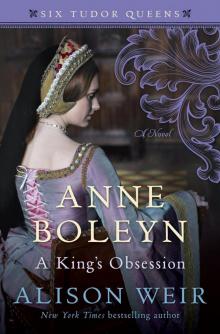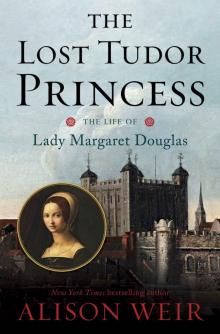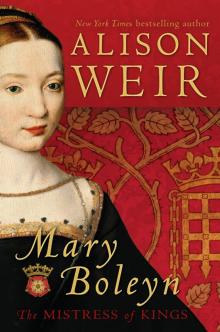- Home
- Alison Weir
Henry VIII: The King and His Court Page 5
Henry VIII: The King and His Court Read online
Page 5
In 1526, the Eltham Ordinances specifically forbade anyone to “bring to court any boy or rascal”;4 in 1533, “all vagabonds and other idle persons which follow the court” were given a day to get out,5 while in 1543, orders were given that no one was to keep any page or boy contrary to the King’s ordinances.6 Strangers were not only a security risk; they also appropriated food and lodgings to which they were not entitled, thus placing a further strain on overstretched household resources. Yet it proved impossible to control the problem, because the Sergeant Porter, who manned the palace gates, had a staff of only five Yeomen and two Grooms.7
Most people who visited the court came in search of employment, preferment, land, privileges, or the patronage of some influential personage. The status and prestige of courtiers depended largely upon nearness to the King. Those close to Henry were therefore in a position to advance the fortunes of less fortunate petitioners, and so extend “good lordship” to them. Petitioners could themselves become patrons of those even further from the throne, and thus was formed a complicated web of clientage. Such patronage could be a highly lucrative business, for every favour had its price.
Sometimes, petitioners might be fortunate enough to present their pleas to the King himself at his “coming forth” from his apartments, or when he was about to go hunting, when he was said to be especially receptive to requests. Although Henry knew that those who came to court were “desirous both of spoil and glory,”8 he could be prodigiously openhanded, and successive ministers had a tough job curbing his impulsive generosity.
For Henry VIII, the ideal courtier was one who, whatever his rank, offered good service and congenial companionship. Both frequently led to preferment and honours. Personal service and usefulness to the monarch were the chief requirements of a Renaissance courtier and could confer great power and influence, since courtiers who offered these had the King’s ear and controlled access to him. Such personal service was often combined with political responsibility, since those who helped the King govern were usually among his intimates. However, it was not Henry’s policy to delegate responsibility to a courtier who lacked the ability to bear it, however good a friend he might be.
As a result of his constantly changing enthusiasms and shifts of policy, Henry’s court was often divided by fluctuating courtier factions dedicated to promoting themselves and their ideas. Unable to confront or oppose the King directly, they used the politics of persuasion to achieve their aims.
Charles de Marillac, the French ambassador, wrote in 1540: “The subjects take example from the Prince, and the ministers seek only to undo each other to gain credit; and under colour of their master’s good, each attends his own. For all the fine words of which they are full, they will act only as necessity and interest compel them.”9
Henry’s successive marriages brought to prominence families of a particular political or religious persuasion, such as the Boleyns, the Seymours, the Howards, and the Parrs. Generally, courtiers in favour could attract parties of supporters. These factions, however, were rarely stable; they shifted in composition and opinions, and their existence depended on the current situation or on whoever was chief minister. Nevertheless, they were an essential part of the political process in Tudor times.
In 1528, Castiglione’s The Courtier was published in Italy, enshrining the virtues and qualities of the ideal courtier. Modelled upon Cicero’s orator, such a courtier would be eloquent, learned, and well-informed, and thus able to influence and manipulate his ruler. He also had to be an example of chivalry and courtesy, a lover of the arts, and expert in martial exercises and sports. The book was based on the ideals of antiquity, and it enjoyed huge popularity, even in remote England, where its influence upon the court was felt almost immediately.
The ideal was much removed from the realities of courtier life. Sir Thomas More believed that a courtier had no choice but to compromise his moral principles and his honesty in order to survive—a view echoed by the poet Sir Thomas Wyatt, who, while he recognised why people were attracted to the court, cynically wrote of men greedy for gold, buying friends and selling women, betraying friendships for profit, and pretending to be virtuous. 10
At court, wrote Sir Francis Bryan, there was “overplus malice and displeasures,”11 while Marillac loathed “the tainted air of the court.”12 “Every man,” warned John Husee, Lady Lisle’s agent, should “beware the flattering of the court”; Queen Jane Seymour had asked him to deter his mistress from sending her daughters to a place that was “full of pride, envy, indignation, mocking, scorning and derision.”13 The superficial life of outward courtesy, frivolity, luxury, and idle pastimes masked deep-seated frustrations, resentment, vicious intrigue, treachery, and backbiting. Most courtiers were motivated by greed; therefore there was intense competition and rivalry.
Life at court could also be routine and boring. There was much waiting and hanging about, and every distraction was welcome. A large number of young men of a military bent unable to find an outlet for their energy and aggression could have caused problems, but Henry ensured that they were provided with many opportunities for sport and feats of arms and a succession of entertaining diversions.
There was great formality at Henry’s court, but the court was also chaotic, wasteful, and hugely expensive to maintain. Continual efforts to improve the efficiency of the royal household met with only varying success, yet given the numbers of people present at court at any one time, its administrators managed rather well. In winter it was not unheard of for between a thousand and fifteen hundred persons to be in residence, of whom only about a hundred had access to the King; up to a thousand persons might be in service in the royal household. Numbers fluctuated depending on the season or the occasion. In the summer, when many courtiers were away on their estates, the court numbered perhaps eight hundred people.
There were probably fewer than a hundred women at court. Many were the wives and daughters of courtiers, and waited on the Queen. Others visited with their husbands, often for ceremonial occasions. Women enjoyed no formal political role at court, although several did involve themselves in politics and intrigues, as will be seen.
Upon marriage, Henry had assigned to Katherine a household of 160 persons, many of whom were female. She had eight ladies-in-waiting. Two, Elizabeth, Lady Fitzwalter, and Anne, Lady Hastings, were the sisters of England’s premier peer, the Duke of Buckingham. They served alongside the Countesses of Suffolk, Oxford, Surrey, Shrewsbury, Essex, and Derby. By 1517, some of these ladies had been replaced by the Countess of Salisbury, Lady Guildford, Lady Maud Parr, and Lady Elizabeth Howard, wife of Sir Thomas Boleyn. 14 Sir Thomas’s brother, Sir Edward, and his wife Anne would also join the Queen’s household in the 1520s.
Katherine was also attended by thirty maids of honour, among them the Ladies Dacre, Scrope, Percy, Ferrers, and Bergavenny (who was Buckingham’s daughter, Mary Stafford)—their names a roll call of the mediaeval peerage. Most of their husbands served in the King’s household, creating an intricate network of family ties among the chief courtiers.
The other maids of honour included Gertrude Blount, daughter of Lord Mountjoy, and Maria de Salinas, who had come with Katherine from Spain. The daughter of a Castilian nobleman and a former maid of honour to Queen Isabella, Maria selflessly had shared the tribulations of Katherine’s penurious widowhood, shelving her hopes of making a good marriage, and was the lady closest to her, “whom she loves more than any other mortal.” 15 Maria had also earned the esteem of Henry VIII, who named one of his ships in her honour. Her sister Iñez, who was married to a Spaniard then resident in England, may also have been one of Katherine’s attendants.
Jane Popincourt, a Frenchwoman, was another maid of honour; she had once served Elizabeth of York and, since 1500, had attended upon Henry’s sister Mary. Anne Luke, the King’s former nurse, was one of Katherine’s chamberwomen.
Luis Caroz dismissed the ladies of the Queen’s household as “rather simple,”16 but to others her damsels were �
�handsome, and make a sumptuous appearance.”17 Katherine set high standards for her household, but she was a kind mistress and her servants invariably became devoted to her.
The chief officers of the Queen’s household were naturally men. At its head was her Chamberlain, the ageing Thomas Butler, Earl of Ormonde, a veteran of the Wars of the Roses. His post was a virtual sinecure, since most of his duties were carried out by Sir Robert Poyntz, who was later appointed the Queen’s Chancellor.18 Sir Thomas Bryan, the Vice Chamberlain, would later be replaced by Sir Edward Baynton, who would hold this office under all the King’s subsequent wives. Katherine had her own Steward and Keeper of her Privy Purse; Griffin Richards, her Clerk of the Signet, had formerly worked for Margaret Beaufort.19
There were only eight Spaniards in the Queen’s household, among them her secretary, John de Scutea; her apothecary; and her physicians, the humanist Ferdinand de Vittoria and Miguel de la Sá. Most of her original Spanish servants had returned to Spain.
Two devout Englishmen, Father William Forrest and the Observant John Forest, were among Katherine’s chaplains. Her confessor (since 1508) was a Castilian Franciscan, Fray Diego Fernandez. By virtue of his position and his mesmeric, forceful personality, he was said to wield more influence over the Queen than anyone else. Because he was also insufferably proud and a manipulative intriguer, he was much vilified by those who feared his hold over his mistress, notably successive Spanish ambassadors, who even expressed fears—before her marriage—that he was her lover. What they really resented was the friar’s advice to the Queen to “forget Spain and gain the love of the English.”20 But there was no denying the fact that the friar was a notorious womaniser who behaved “scandalously, in an extreme manner.”21 Even Henry VII had warned Katherine against him, using “strong words,”22 but she refused to believe anything of Fray Diego. That she was never his lover is borne out by her sworn oath in 1529 that she had come to the King “a true maid, without touch of man.”23 Nor would Henry VIII have allowed her to retain the friar if he had believed the gossip. Yet Fray Diego would continue to cause trouble for some years to come.
Many of those at court had to be housed and fed. It was the Lord Chamberlain’s responsibility to decide who was entitled to lodgings, meals, and “bouche of court”—a daily allowance of bread, wine, beer, candles, and firewood. The rations were allocated according to rank and the season of the year. This privilege was generally extended to the courtiers closest to the King, the great nobles, the chief officers of the household, and important servants. Those who were not entitled to it received just their wages or fees.
Numbers at court were swelled by the servants whom the courtiers were allowed to bring with them, in recognition of their status. Each was allowed a number appropriate to his rank: a duke or archbishop might have twelve servants, the Lord Chamberlain ten, and a Gentleman of the Privy Chamber four, while Sergeants and Clerks were permitted just one each. The Sergeant Porter was ordered to forbid entry to any surplus servants,24 although there is ample evidence that the rules were bent.
The royal palaces were designed to accommodate large numbers of courtiers and servants, and whole ranges were given over to courtier lodgings, as in the Base Court at Hampton Court, which could house forty courtiers, 25 and the Green Court at Knole. Servants usually slept in rooms above their departments. The entitlements to lodgings were laid down in the Household Ordinances, and were the responsibility of the Lord Steward, but in smaller houses it was often a case of first come, first served. Only about a hundred courtiers were entitled to permanent rooms at court, most of them councillors, peers, and the chief officers— in short, all those on whom the King relied for advice and efficient service. The Duke of Norfolk, for example, had lodgings in nine of the King’s palaces. When he was not at court, no one else could use them.
The gentlemen attendant upon the King were also entitled to lodgings at court, although when on duty they would sleep in the privy chamber, on call should their master need them.26 Some important courtiers and officers were given houses within or near the palace precincts, while Cardinal Wolsey was even allowed to stay at Eltham Palace and Thomas Cromwell sometimes had the use of St. James’s Palace.27 Other courtiers had homes near the palaces: at Greenwich, several courtiers owned houses in the town,28 and many nobles had mansions in the Strand, near to Westminster and Whitehall.
Courtier lodgings were of two types: double lodgings had two rooms, each with a fireplace and a garderobe, or “stool chamber,” while single lodgings had just one room with a fireplace. Their occupants were obliged to use the public latrines. All lodgings were meant to accommodate a courtier and his or her servants, so space was very limited. The most desirable lodgings, however small, were those nearest the King’s apartments.29
While the Office of the King’s Works would take care of repairs and maintenance, each courtier was responsible for furnishing his lodging and keeping it clean. Occasionally, the King would help: Henry provided his cousin the Marquess of Exeter with a pallet from the Royal Wardrobe of the Beds and ordered the Office of Works to make him two stools.30 When, in 1534, Lord Rochford wanted mullioned windows in his lodgings, the King paid to have them installed.31
Aspiring courtiers who had not been allocated lodgings had to ask the King’s permission to come to court. The giving or withholding of such permission was a fair indicator of whether or not the supplicant was in favour. The termination of a courtier’s right to lodgings was usually an ominous sign; if he was allowed to remain in attendance upon the King, he could face the ruinous cost of paying for accommodation near the court. Banishment from the King’s presence was calamitous in the extreme, and meant utter social disgrace: Sir Ralph Sadler told Thomas Cromwell that compulsory absence from court would mar a man’s fortunes forever.32
The Comptroller of the Household allocated stabling for courtiers’ horses and beds for their retainers: twenty-four horses and nine beds were allowed for a duke or archbishop, three horses and two beds for a chaplain. 33
At first courtiers were allowed to bring dogs with them, but the animals caused such a nuisance that in 1526 the Eltham Ordinances banned all dogs except ladies’ lapdogs from the precincts of the court; if courtiers did obtain the King’s permission to bring their pets with them, they had to keep them in the kennels provided so that the palace might be “sweet, wholesome, clean and well-furnished, as to a prince’s house and state doth appertain.”34 Ladies were also allowed singing birds. Other animals were kept as pets: Cardinal Wolsey had a cat, while in 1539 the King was offered “two musk cats, two little monkeys and a marmoset.” 35 Katherine of Aragon owned a pet monkey; she appears with it in a miniature by Lucas Horenbout.
Henry VIII kept canaries and nightingales in ornamental birdcages hanging in the windows at Hampton Court. He also kept ferrets, although he forbade courtiers to do so.36
Henry’s favourite pets were his dogs, especially beagles, spaniels and greyhounds; the latter were considered a particularly noble breed. 37 Over the years the King sent hundreds of such dogs, all “garnished with a good iron collar,” as gifts to the Holy Roman Emperor and the King of France.38 Henry’s own dogs wore decorative collars of velvet—permitted only to royal dogs—and kid, with or without torettes (spikes) of silver and gold; some were adorned with pearls or the King’s arms and his portcullis and rose badges. His dogs’ coats were of white silk,39 and the dogs had their fur regularly rubbed down with “hair cloth.”40 Sixty-five dog leashes were found in Henry’s closets after his death.41 Pet dogs were fed bread, not meat, to discourage them from developing hunting instincts. Two of Henry’s dogs, Cut and Ball, were prone to getting lost, and he paid out the huge sum of nearly 15s (about £225 today) in rewards to those who brought them back.42
Henry VIII’s court was never as licentious as the court of Francis I of France. By comparison with his French rival, Henry appeared a paragon of virtue, although he was simply far more discreet and, unlike Francis, he sometimes married his mistresses. T
he fact that Nicholas Wotton, Henry’s ambassador in Paris, was so shocked by the behaviour at the French court suggests that much higher standards prevailed at the English court.
The English were not squeamish about sexual matters; in fact, they were frank, outspoken, and “somewhat licentious in their disposition.” 43 Erasmus commented on the fact that the women always kissed a man on the lips when they greeted him, a custom he found delightful. In a court where women were very much in the minority, and most of the men were away from home, some sexual dalliance was inevitable. Yet the King would not permit any open display of wanton behaviour; he commanded his Knight Harbinger to banish lewd women from his household,44 and foreigners were often impressed by the relative circumspection and dignity of his courtiers. Drunkenness, however, was common.
A double standard certainly prevailed. While fornication or adultery could never tarnish a man’s honour—and many noblemen had complicated private lives—women were expected to be above reproach. Some considered the ladies of the English court to be of easy virtue. In 1536, Eustache Chapuys, the Spanish ambassador, was sceptical about Jane’s Seymour’s much vaunted chastity: “You may imagine whether, being an Englishwoman and having been long at court, she would not hold it a sin to be still a maid.” 45 That same year, when the King’s niece, the Lady Margaret Douglas, was caught in an illicit love affair with Lord Thomas Howard, an observer commented that it would not have been surprising if she had slept with him, “seeing the number of domestic examples she has seen and sees daily.” 46

 Richard III and the Princes in the Tower
Richard III and the Princes in the Tower Britain's Royal Families: The Complete Genealogy
Britain's Royal Families: The Complete Genealogy The Lady in the Tower: The Fall of Anne Boleyn
The Lady in the Tower: The Fall of Anne Boleyn Six Wives of Henry VIII
Six Wives of Henry VIII Elizabeth of York: A Tudor Queen and Her World
Elizabeth of York: A Tudor Queen and Her World Captive Queen
Captive Queen Innocent Traitor
Innocent Traitor The Marriage Game
The Marriage Game A Dangerous Inheritance
A Dangerous Inheritance Katherine of Aragón: The True Queen
Katherine of Aragón: The True Queen The Marriage Game: A Novel of Queen Elizabeth I
The Marriage Game: A Novel of Queen Elizabeth I Princes in the Tower
Princes in the Tower Anne Boleyn: A King's Obsession
Anne Boleyn: A King's Obsession Traitors of the Tower
Traitors of the Tower Mistress of the Monarchy: The Life of Katherine Swynford, Duchess of Lancaster
Mistress of the Monarchy: The Life of Katherine Swynford, Duchess of Lancaster Queens of the Conquest: England’s Medieval Queens
Queens of the Conquest: England’s Medieval Queens Eleanor of Aquitaine: A Life
Eleanor of Aquitaine: A Life Mary, Queen of Scots, and the Murder of Lord Darnley
Mary, Queen of Scots, and the Murder of Lord Darnley Henry VIII: The King and His Court
Henry VIII: The King and His Court Queen Isabella: Treachery, Adultery, and Murder in Medieval England
Queen Isabella: Treachery, Adultery, and Murder in Medieval England Katheryn Howard, the Scandalous Queen
Katheryn Howard, the Scandalous Queen Arthur- Prince of the Roses
Arthur- Prince of the Roses The Wars of the Roses
The Wars of the Roses Eleanor of Aquitaine: By the Wrath of God, Queen of England
Eleanor of Aquitaine: By the Wrath of God, Queen of England Mary Boleyn: The Great and Infamous Whore
Mary Boleyn: The Great and Infamous Whore Jane Seymour: The Haunted Queen
Jane Seymour: The Haunted Queen Anna of Kleve, the Princess in the Portrait
Anna of Kleve, the Princess in the Portrait Lancaster and York: The Wars of the Roses
Lancaster and York: The Wars of the Roses The Grandmother's Tale
The Grandmother's Tale The Princess of Scotland (Six Tudor Queens #5.5)
The Princess of Scotland (Six Tudor Queens #5.5) The Lady Elizabeth
The Lady Elizabeth Katherine Swynford: The Story of John of Gaunt and His Scandalous Duchess
Katherine Swynford: The Story of John of Gaunt and His Scandalous Duchess The Curse of the Hungerfords
The Curse of the Hungerfords The Lost Tudor Princess: The Life of Lady Margaret Douglas
The Lost Tudor Princess: The Life of Lady Margaret Douglas Eleanor of Aquitaine
Eleanor of Aquitaine Mistress of the Monarchy
Mistress of the Monarchy The Lost Tudor Princess
The Lost Tudor Princess Henry VIII
Henry VIII Anne Boleyn, a King's Obsession
Anne Boleyn, a King's Obsession A Dangerous Inheritance: A Novel of Tudor Rivals and the Secret of the Tower
A Dangerous Inheritance: A Novel of Tudor Rivals and the Secret of the Tower Elizabeth of York
Elizabeth of York Katherine of Aragon, the True Queen
Katherine of Aragon, the True Queen Katherine Swynford
Katherine Swynford Wars of the Roses
Wars of the Roses Queens of the Conquest
Queens of the Conquest Mary Boleyn
Mary Boleyn Britain's Royal Families
Britain's Royal Families The Tower Is Full of Ghosts Today
The Tower Is Full of Ghosts Today Life of Elizabeth I
Life of Elizabeth I Anne Boleyn A King's Obssession
Anne Boleyn A King's Obssession Lancaster and York
Lancaster and York Jane Seymour, the Haunted Queen
Jane Seymour, the Haunted Queen Queen Isabella
Queen Isabella The princes in the tower
The princes in the tower